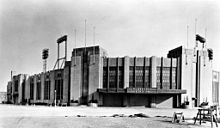

Roosevelt Stadium is the name of a former baseball park on N.J. Route 440 and Danforth Avenue in Jersey City, New Jersey.
It was built in 1937, as a Works Progress Administration project on the grounds of what was the Jersey City Airport. [1] It was named for President Franklin D. Roosevelt, the author of that New Deal agency. It was designed in Art Deco style.
The stadium saw its most common use for high school football, as Jersey City's William L. Dickinson, James J. Ferris, Abraham Lincoln, Henry Snyder high schools and St. Peter’s Prep all used the stadium, particularly on Thanksgiving Day, when Dickinson and St. Peter’s would sell it out.
It was used for some "home" games by the Brooklyn Dodgers during their last couple of seasons in Brooklyn, 1956 and 1957, in part as a negotiating tactic with the Borough of Brooklyn, in pursuit of a new stadium to replace Ebbets Field. While it had just 24,000 seats as opposed to Ebbets Field's 31,497, Roosevelt Stadium had 10,000 parking spaces compared to Ebbets Field's 700. The Dodgers' negotiation came to naught, and the team moved to Los Angeles, California in 1958.
It was also the home field of the Jersey City Giants, a farm team of the New York Giants in the Triple-A International League from 1937 to 1950, the Jersey City Jerseys of the IL in 1960 and 1961, the Jersey City Indians of the Double-A Eastern League in 1977 and, following a change in minor-league affiliation, the Jersey City A's of the EL in 1978.
On April 18, 1946, Roosevelt Stadium hosted the Jersey City Giants' season opener against the Montreal Royals, marking the professional debut of the Royals' Jackie Robinson. In his five trips to the plate, Robinson made four hits, including a three-run homer, scored four runs and drove in three; he also stole two bases in the Royals 14-1 victory.
The Giants finished first in the IL in 1939 and 1947, but no Jersey City team ever went on to win a pennant in postseason play.
In 1940, former heavyweight champion Max Baer beat "Two Ton Tony" Galento at Roosevelt Stadium, and Marcel Cerdan defeated Tony Zale in a middleweight fight. In 1950, Sugar Ray Robinson defended his welterweight title; in 1951, Jersey Joe Walcott beat heavyweight champion Ezzard Charles.
The stadium saw sporadic use during its final years of existence. One of its more celebrated events was a Grateful Dead concert on August 4, 1976. The Allman Brothers Band, The Band, The Beach Boys, Eric Clapton, Tony Bennett, and Crosby, Stills, Nash and Young, among other performers, used the stadium.
It was finally demolished in 1985, and a housing development named Society Hill opened on the site in 1987.
Dimensions
- Left Field - 330 ft.
- Left Center - 377 ft.
- Center Field - 411 ft.
- Right Center - 377 ft.
- Right Field - 330 ft.
References
- ^ "Jersey City to Get WPA Stadium Fund. Mayor Hague Reports Application for $800,000 Approved for Arena at Airport". New York Times. September 26, 1935, Thursday. Retrieved 2007-08-21.
Mayor Frank Hague of Jersey City announced yesterday he had been informed that the Works Progress Administration had approved the city's application for an $800,000 grant to build a municipal sports stadium.
((cite news)): Check date values in:|date=(help); Cite has empty unknown parameter:|coauthors=(help)
External links
- Info about the stadium
- Info about the Grateful Dead concert
- Collection of photos and drawings
- Encyclopedia of New Jersey
The dimensions listed are for the outfield fence that was added in the 1960"s(??). Before that I believe that most baseball games were played to the brick wall some 100 feet further back. I say 100 feet because there was a full size ice rink (85ft across)behind the fence.
Sources
- Green Cathedrals, by Philip J. Lowry.